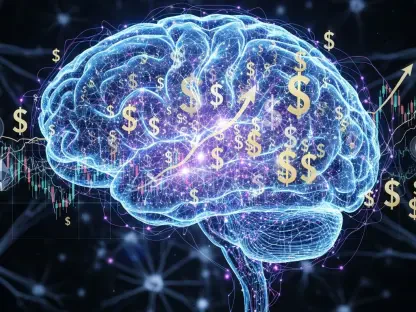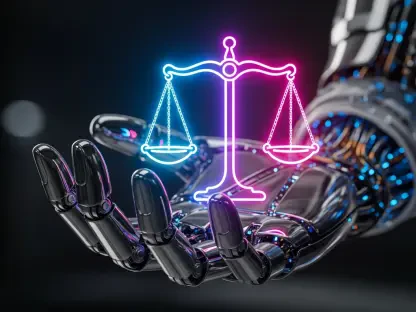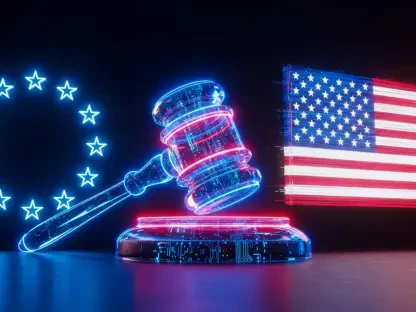The burgeoning field of generative artificial intelligence (AI) has introduced disruptive innovations across multiple sectors, significantly transforming how brands create, market, and protect their identity. With AI technologies now wielding the ability to produce creative content at an unprecedented pace, the associated legal and trademark issues have gained intricate dimensions. Companies utilize AI to generate design elements like logos, catchphrases, and campaign strategies, capitalizing on AI’s potential to reduce costs and extend creative capacities. However, alongside these advantages, AI-driven processes can inadvertently cross into legal gray areas, with the possibility of trademark infringement or dilution being of particular concern. Brand owners and users adopting these sophisticated tools must navigate complex legal waters to effectively protect their intellectual property rights while safeguarding against potential liabilities. This landscape requires a delicate balancing act between leveraging AI’s creative potential and avoiding unintended clashes with existing trademarks.
The Intersection of AI and Trademark Infringement
The ability of generative AI platforms to produce vast amounts of new content quickly presents significant opportunities for creativity and innovation. Simultaneously, these tools also pose substantial risks of trademark infringement. Trademark infringement typically occurs when someone uses a word, symbol, design, or similar identifier in a manner that might confuse consumers regarding the source of goods or services. Given AI’s capacity to generate content that resembles existing trademarks unintentionally, users of AI technologies must be particularly vigilant. Businesses and individuals seeking to utilize AI-generated content to enhance branding or product visibility may unknowingly create material closely resembling established trademarks. As AI systems don’t inherently guard against replications of protected marks, end-users can find themselves in violation, laying ground for legal ramifications. It’s essential for AI users to perform comprehensive reviews and assessments of AI outputs to ensure intended content doesn’t conflict with existing intellectual property rights.
Moreover, the rapid creation capabilities of AI heighten the risk of coincidentally producing materials that infringe on protected trademarks. Despite the absence of deliberate infringement intent, legal accountability can arise from any confusing similarities that mislead consumers about the source or affiliation of products. For instance, a computer-generated logo or slogan that echoes an established brand identity may inadvertently place businesses at risk of litigation. Consequently, meticulous oversight of AI-assisted content production becomes critical, as users navigate trademark regulations to mitigate potential transgressions. The legal landscape surrounding this issue continues to evolve, pressing the need for up-to-date awareness of regulatory frameworks and proactive compliance strategies to prevent infringement disputes from impacting brand integrity and consumer trust.
Understanding Trademark Dilution in the AI Era
Trademark dilution presents another pivotal challenge within the realm of AI content generation, distinct from infringement as it doesn’t rely on customer confusion but rather focuses on the erosion of a trademark’s uniqueness. Two primary forms of dilution, blurring and tarnishment, pose significant concerns for AI-created content. Blurring occurs when a mark’s distinctiveness is weakened from its association with unrelated goods or services, diluting its unique value. AI-generated logos or brand identifiers similar to famous marks may inadvertently contribute to blurring, as they might confuse the specific associations the public holds. Tarnishment, on the other hand, involves using a famous mark in a manner that could harm its reputation. AI creations that insert a trademark into inappropriate or offensive contexts can lead to tarnishment, thereby damaging brand perception and value.
The intricacies of dilution and its potential ramifications necessitate careful examination by those employing AI in content creation. As brands utilize AI-generated elements in marketing or product presentation, legal evaluations should be incorporated into creative workflows to safeguard against dilution claims. For owners of well-known trademarks, active monitoring and enforcement of their rights become imperative to prevent diminished brand strength. Vigilance in detecting AI-associated dilution risks allows brand owners to not only defend their reputation but also maintain the commercial distinctiveness that underpins their market position. The evolving digital landscape underscores the necessity for robust brand protection strategies, ensuring iconic trademarks retain their exclusive identity amidst the flood of AI-driven innovations.
Leveraging AI Responsibly for Brand Protection
The integration of AI into brand strategy offers a dual-edged advantage, necessitating prudent management practices to harness benefits while mitigating risks. Brand owners can employ AI consciously to enrich creative processes, ensuring that outputs align with legal compliance and trademark protections. Regular audits and consultations with legal professionals facilitate awareness of potential trademark conflicts before they evolve into significant disputes. Documented oversight during AI content creation provides a framework for defending against infringement or dilution allegations, as it demonstrates intent to adhere to intellectual property laws. Accountability mechanisms, such as human review stages embedded into AI workflows, can significantly alleviate risks. By maintaining a balance between AI’s capabilities and diligent trademark protection methodologies, brands can optimize the scope of AI while ensuring alignment with legal mandates.
Furthermore, forging collaborations with legal experts specializing in intellectual property becomes crucial for brands navigating this intricate landscape. Expertise in examining AI outputs against existing trademarks can provide valuable insights to preemptively address legal vulnerabilities. Establishing clear protocols for content review, using advanced trademark monitoring systems, equips businesses to swiftly identify and rectify potential trademark issues. Brand owners who proactively engage with AI’s potential and complexities demonstrate leadership in innovation while preserving their intellectual assets. As AI evolves, staying abreast of technological advancements and legislative developments helps align business strategies in a legally sound manner, protecting brand value and ensuring compliance within an ever-shifting trademark environment.
Steps Forward in the AI and Trademark Arena
The rapidly developing field of generative artificial intelligence (AI) is revolutionizing numerous industries by reshaping how brands develop, market, and safeguard their identities. Modern AI technology has made it possible to produce creative content remarkably swiftly, introducing complex legal and trademark challenges. Companies now harness AI to craft design components, such as logos, slogans, and marketing plans. This helps cut costs and broaden creative horizons. Despite these benefits, AI-driven activities can sometimes unintentionally veer into legal gray areas, raising concerns about potential trademark infringement or dilution. Brand owners and individuals using these advanced tools must skillfully navigate the complicated legal landscape to shield their intellectual property rights and avoid potential risks. The current environment necessitates carefully balancing AI’s innovative abilities with the need to prevent unintentional conflicts with existing trademarks, ensuring both creative and legal integrity.









